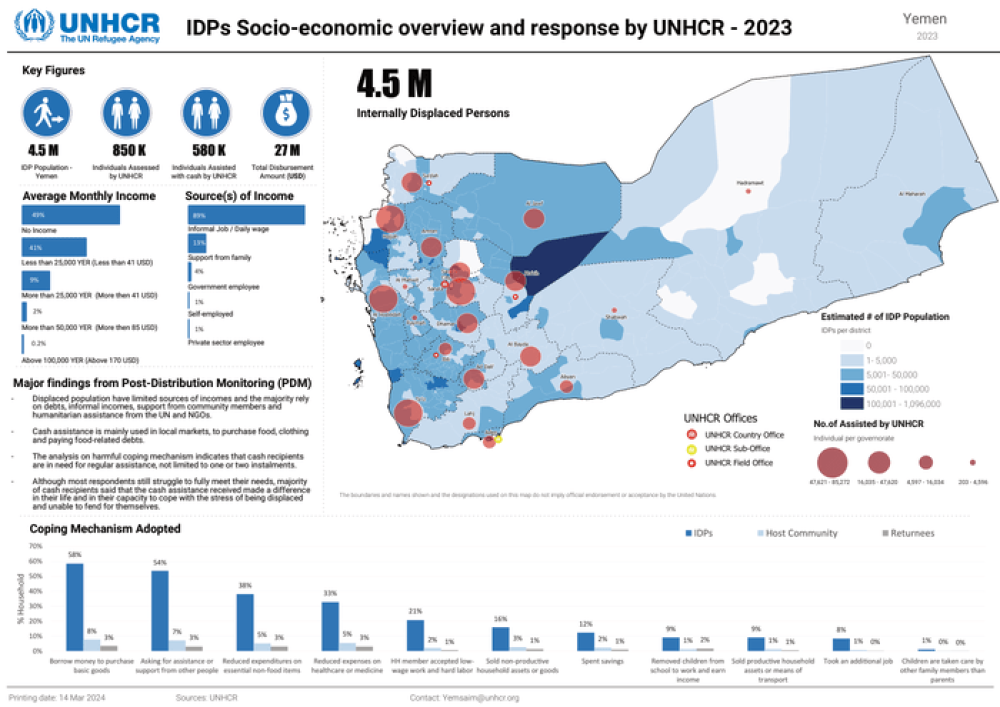IDPs in Yemen: Socio-economic overview and cash responses


Yemen remains among the most critical humanitarian crises globally. Almost ten years of conflict have created and exacerbated vulnerabilities and eroded resilience and capacities of the general population to cope. Moreover, Yemen is home to an estimated 4.5 million internally displaced people (IDPs) and over 70,000 refugees and asylum seekers. These displacement- affected individuals and families are particularly vulnerable, with reduced access to basic services and livelihoods, facing numerous protection risks, often daily. With few options left, many turn to harmful coping mechanisms to get by, including skipping meals, school dropout, child labour, taking out loans, moving to poorer quality shelter, and early marriage.
To monitor the needs and inform country strategy and response, identify those who are most vulnerable, and determine eligibility for assistance, UNHCR continually conducts needs and vulnerability assessments of the IDP population. UNHCR’s comprehensive assessments collect household demographics, displacement information, economic capacity, vulnerabilities, shelter conditions, and civil registration and documentation data. In 2023, UNHCR conducted 136,913 household assessments, covering 820,440 individuals.
The results of these assessments indicate high levels of socio-economic vulnerabilities among IDP households. Opportunities to earn an income are limited and largely consist of informal and hazardous jobs. Indeed, 48.6% of the population report no source of income and 41.5% report monthly incomes of less than USD 50. As a result, IDP households continuously struggle to meet their basic needs and many turn to harmful coping mechanisms to get by. UNHCR assessments show that 69.6% rely on debt to meet their basic needs, 46.4% reduce expenditure on essential non-food items, 41.1% reduce expenditure on healthcare and medicine, 10.8% sell productive assets, and 11.9% of children drop out of school. Just 11% of the assessed IDP population can meet their daily food needs. The majority purchase less preferred or cheaper, lower quality food (70%), reduce portion sizes (52.7%), or reduce the number of meals per day (48.2%). For the majority of IDPs, humanitarian assistance, including in-kind food assistance and cash transfers, remain a critical source of life-saving support.
In Yemen, UNHCR uses various cash-based interventions to meet immediate basic needs and to mitigate protection concerns and harmful coping mechanisms in an efficient and dignified manner. In 2023, UNHCR reached 83,618 households (583,619 unique individuals) through Multi-Purpose Cash Assistance, Cash for Shelter, Winterization cash, and Emergency Cash Assistance.
While such humanitarian assistance continues to play a critical role in responding to immediate needs, it is stretched and unsustainable thus, there is a clear need to combine this life-saving assistance with projects leading towards durable solutions in order to foster greater livelihood and self-reliance opportunities. Indeed, among the IDPs willing to return to their area of origin (35.1% of the IDP population), 62.5% referenced limited access to livelihoods opportunities as a barrier, while 44.9% referenced adequate housing. Inter-linked interventions from both the private and public sectors should be leveraged to create sustainable opportunities for IDPs in Yemen, reducing reliance on dwindling humanitarian assistance.

Sana’a — The United Nations has confirmed that Yemen’s Humanitarian Response Plan (YHRP) for 2025 received only about 28 percent…

Aden — Security sources reported that traffic accidents have left more than 5,000 victims in areas under the control of Yemen’s interna…

Aden - Yemenia Airways flights to Aden were canceled on Thursday morning, in addition to a Djiboutian Airlines flight that had been scheduled to de…